(304758 products available)




































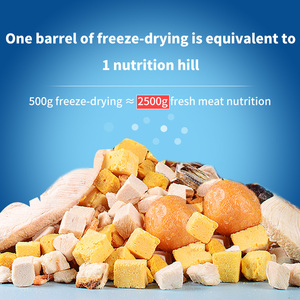

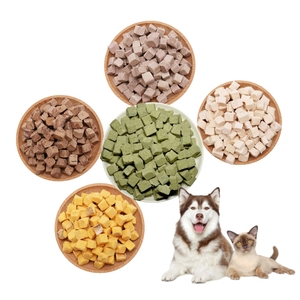































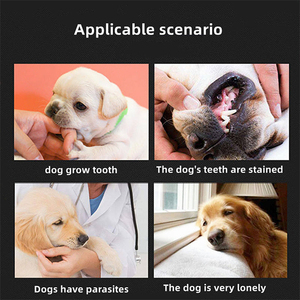









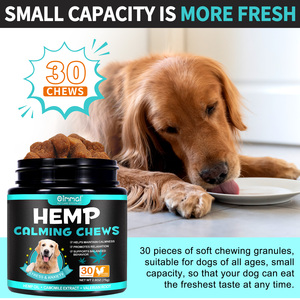





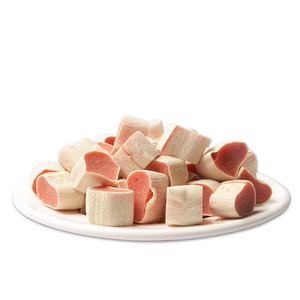


















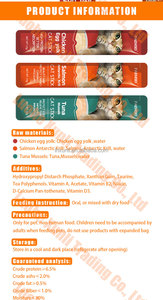

























































































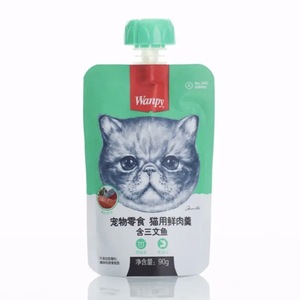






















Treats are snacks that are given to pets. They are important for training, rewarding good behavior, and improving the overall diet. Pet treats come in different types, each serving a unique purpose and catering to various pet preferences. Here are some popular types of pet treats:
Dog training treats:
Dog training treats are small, tasty snacks used to reward and encourage dogs when they learn commands or behave well. These treats are often soft, easy to chew, and come in various flavors that dogs like. They are helpful because dogs remember things better when they are praised right away with these small rewards. Dog training treats help make learning fun and keep dogs interested.
Dog dental chews:
Dental dog chews are snacks that dogs chew to keep their teeth clean and healthy. These chews are made to remove plaque and tartar buildup from teeth and freshen breath. They come in different shapes and sizes, making them fun for dogs to chew. Some dog dental chews are hard like bones, while others are softer. Giving dogs dental chews regularly can help prevent bad breath and keep their teeth strong, just like regular vet check-ups are important for their dental health.
Dog biscuits:
Dog biscuits are crunchy snacks for dogs. They come in various flavors, such as meat, vegetables, and grains, to make them tasty. Dog biscuits are often made with healthy ingredients to provide extra nutrition. They are a popular treat that dogs enjoy eating. Dog biscuits can be given as rewards, snacks, or just to show dogs love. Their hard texture helps keep dog's teeth clean by removing plaque when chewed. Dog biscuits are a traditional and wholesome treat enjoyed by many dogs and their owners.
Jerky dog treats:
Jerky dog treats are chewy snacks made from dehydrated meats like chicken, beef, or turkey. The meat is sliced thin and dried out to preserve it, which makes these treats tasty and healthy for dogs. Since jerky is made from real meat, many dogs find it very flavorful. Jerky treats are high in protein, good for dog's muscles and energy. They come in different flavors and shapes, so dogs enjoy chewing them. Jerky dog treats are a popular choice for pet owners who want a natural, nutritious snack their dogs will love.
Rawhide dog chews:
Rawhide dog chews are popular treats made from the inner layer of cow or horse hides. The hides are cleaned, pressed, and treated to make them safe for dogs to chew. Rawhide provides a long-lasting chew that keeps dogs busy and satisfies their natural urge to chew. It can help prevent destructive chewing behavior by redirecting chewing. Chewing rawhide may also help clean dogs' teeth and freshen breath. These chews come in various shapes and sizes to suit different dog breeds. Rawhide dog chews are a widely enjoyed snack that provides entertainment and dental benefits for pet dogs.
Appearance:
Dog treats are designed to be visually appealing to pet owners. They come in various colors, shapes, and sizes. For example, some treats look like small biscuits, while others are in the form of jerky. Dog treats may also have multiple colors, such as bright red, green, or yellow, to attract attention. These colors can come from natural fruit and vegetable ingredients or food coloring. In terms of shape, dog treats are often made into simple rounds or flat squares. However, many manufacturers offer unique mold designs to create fun shapes like bones, hearts, stars, and animals. Some treats even have decorative elements like frosting or sprinkles to make them look more exciting.
Packaging Design:
Packaging is an important part of the dog treat design. It keeps the treats fresh and protects them from breaking. Most dog treat packages are made from materials like plastic or foil that can be resealed after opening. This helps maintain the treat's crunchiness and prevents moisture from getting in. The packaging is often clear or partially transparent so pet owners can see the treats inside. It may also include windows or cut-out shapes that reveal the product's color and shape. To make the packaging convenient, it is designed to be easy to open. Some bags have tear notches or ziplock seals. Jars and containers also feature screw tops or pop-up lids for straightforward access.
Functional Aspects of the Packaging:
Besides appearance, the packaging has important functional features. The material used needs to be strong enough to withstand rough handling during shipping and storage without breaking. Additionally, the seals and closures ensure the treats do not crumble due to vibration or impact. Proper sealing also keeps the air out, which is necessary since dog treats are often crunchy. Overall, the packaging design protects the treats and makes them easy for pet owners to enjoy with their dogs.
Nutritional Information:
In the dog treat design, another crucial aspect is clearly communicating the nutritional information and feeding guidelines on the packaging. This allows pet owners to understand what they are giving their dogs and how much is appropriate. The treats are also designed to meet different dietary needs. Some dogs require low-fat snacks, while others need grain-free options. Treats are created with various fruits, vegetables, and other healthy ingredients. There are even functional treats designed to promote dental health, skin and coat wellness, and weight management. The design of these treats incorporates features like ridges or textures for brushing teeth and specialized components like omega fatty acids for overall health support.
These scenarios show how relevant and important the pet food packaging is. It is important for the safety, freshness, and convenience of the pet food. The packaging protects the food inside. It keeps it fresh and safe for pets to eat.
Retail stores
Retail stores sell pet food in packages. The packages attract customers and give information about the food inside. The packages have handles or easy-to-open seals. They make it easy for pet owners to carry and feed their pets.
Online delivery
Online retailers deliver pet food in packages. The packages are designed to protect the food during shipping. They may have extra cushioning or sturdy boxes. The packaging needs to be opened easily so that pet owners can quickly access the food inside.
Veterinary clinics
Veterinary clinics use different types of packaging for pet food. The packaging may have resealable tops. The packaging is convenient for staff to use when feeding animals. The clinic may also sell packaged pet food to pet owners. The food is for animals who need special diets.
Pet shelters and rescue organizations
Pet shelters use large bulk packaging for economical food. The food must be stored properly. Shelters need packaging that is easy to open and reseal. They also need packaging that keeps food fresh for a long time.
Home storage
Some pet owners buy pet food in bulk. They need packaging that keeps the food fresh until needed. The packaging may have airtight seals or bins with refilling mechanisms.
Special events or travel
For travel, pet owners need packaging that is convenient and mess-free. The packaging may include single-serving pouches or resealable bags. The packaging is easy to carry and helps keep the food fresh.
For business buyers, selecting the right cat treats involves considering various factors. Here are some key points to keep in mind:
Target Market and Customer Preferences:
Understand the target market and customer preferences. Identify the cat owners' demographics and psychographics. Know the trends and demands in the cat treats market. Do market research. Consider factors like health-focused treats, natural ingredients, unique flavors, or functional treats for specific needs.
Quality and Safety Standards:
Prioritize the quality and safety of cat treats. Choose treats made from high-quality, safe ingredients. Ensure they are free from harmful additives or preservatives. Select suppliers who adhere to pet food safety regulations and use good manufacturing practices (GMP) to ensure the safety and quality of their cat treats.
Nutritional Value:
Consider the nutritional value of cat treats. Choose treats that complement a balanced diet for cats. Look for treats that provide beneficial ingredients like proteins, vitamins, and minerals. Consider functional treats that support dental health, skin health, or weight management.
Diversity and Innovation:
Opt for cat treat options that are diverse and innovative. Look for new flavors, textures, and forms to attract cat owners. Consider treats that offer unique ingredients or combinations, such as superfoods or novel protein sources. Stay updated on industry trends and emerging innovations to offer treats that stand out in the market.
Packaging and Shelf Life:
Pay attention to the packaging and shelf life of cat treats. Choose packaging that protects the treats from moisture, air, and light to maintain freshness. Look for resealable bags or containers for convenience. Consider the shelf life of the treats to ensure they can be stored and sold without compromising quality.
Supplier Reliability:
Choose suppliers who are reliable and who can supply cat treats. Ensure they have a good reputation in the industry. Check their ability to meet demand and provide consistent product quality. Also, check their transparency in sourcing and manufacturing processes. Collaborate with suppliers who can provide the necessary documentation and support for the selected cat treats.
By considering these factors, business buyers can make informed decisions when choosing cat treats. They will choose treats that meet the needs of cat owners and their cats. They will also choose treats that have good quality, safety, and market potential. Selecting the right cat treats will help to drive sales and satisfy customers.
Q1: What are the benefits of using natural dog treats?
A1: Natural dog treats are minimally processed and do not contain artificial additives. They promote overall health and well-being.
Q2: How can dog owners manage their pet's weight with dog treats?
A2: Look for low-calorie dog treats or those with reduced fat content. Also, opt for bulk dog food supplies to ensure the dog is always full.
Q3: Are functional dog treats effective?
A3: Yes, functional dog treats are formulated with specific ingredients that can provide health benefits to dogs.
Q4: What are the signs of an allergic reaction in dogs after eating a new dog treat?
A4: Common signs include itching, hives, swelling, gastrointestinal upset, and ear infections. If they occur, stop giving the dog the new treat and consult a veterinarian.
Q5: How can dog owners choose safe and healthy treats for their pets?
A5: Look for high-quality ingredients. Avoid additives and preservatives and consider the dog's dietary needs and preferences.
The keyword "treats" in the homegarden category shows a consistent web search volume trend with an average monthly web search volume of 27,100. Over the past year, there has been a notable increase of 22%, despite a flat three-month change. The data highlights a steady web search volume from November 2023 to May 2024, followed by a rise in June 2024, where web searches increased to 33,100 and maintained this level through October 2024.
Analyzing the monthly search data, "treats" experienced no fluctuations from November 2023 to May 2024, indicating a stable interest during these months. However, starting in June 2024, there was a sudden increase in web searches, which plateaued at higher levels through October. This pattern suggests a seasonal variation, where interest in treats peaks during the summer and early autumn months.
The sustained interest in "treats" from a data perspective points to a consistent consumer engagement throughout the year, with a heightened period during warmer months. This could be attributed to various seasonal activities or consumer behavior changes during this time, although the specific reasons for these trends are beyond the scope of the provided data.